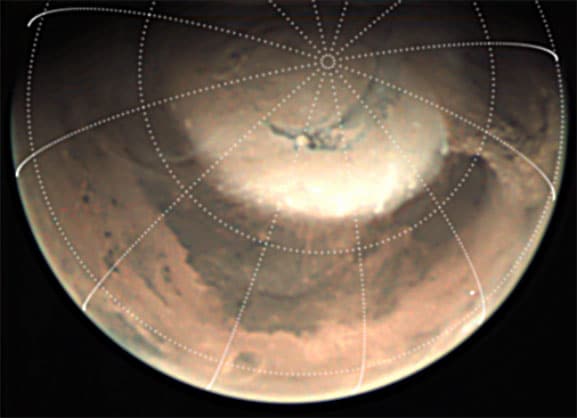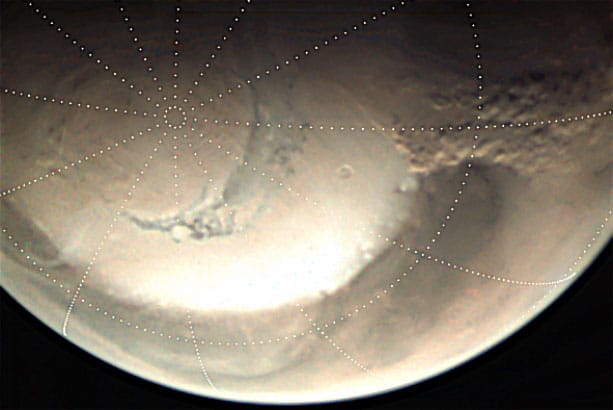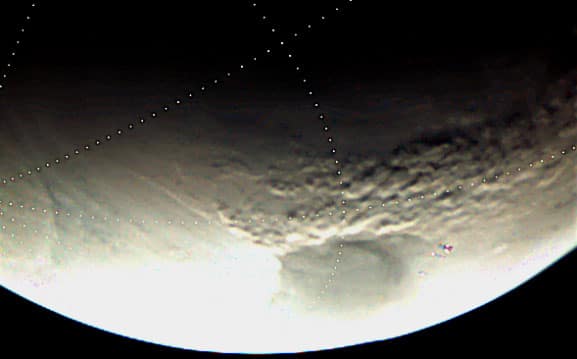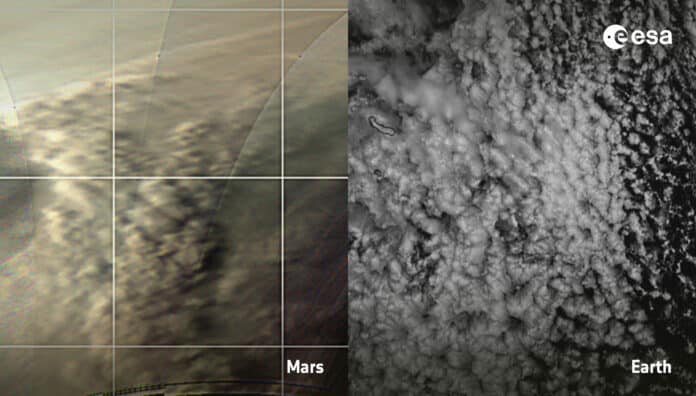The Springtime season in Mars’ northern hemisphere is characterized by rich atmospheric dynamical activity. This activity occurs at the polar cap’s edge, often revealed by the presence of local dust storms.
A new study dives deeper into two martian dust storms that occurred near the martian North Pole in 2019. The cloud patterns are surprisingly Earth-like, pointing to similar formation processes.
ESA’s Mars Express monitored the storms during springtime at the North Pole. It found that Mars churns up surprisingly Earth-like cloud patterns reminiscent of those in our planet’s tropical regions.
Two cameras on board Mars Express – the Visual Monitoring Camera (VMC) and the High-Resolution Stereo Camera (HRSC) – together with the MARCI camera on board NASA’s Mars Reconnaissance Orbiter, imaged the storms from orbit.

The VMC image sequence demonstrates how the storms exhibit recurring cycles of growth and disappearance over days. The broader views of the HRSC images clearly show spiral structures. The spirals, which range from 1000 to 2000 km, share the same extratropical cyclone genesis as those seen in Earth’s mid-latitudes and latitudes.
The images reveal a particular phenomenon on Mars. They show that the martian dust storms are made up of regularly spaced smaller cloud cells arranged like grains or pebbles. The texture is also seen in clouds in Earth’s atmosphere.
The VMC image sequence demonstrates how the storms exhibit recurring cycles of growth and disappearance over the course of days. The broader views of the HRSC images clearly show spiral structures. The spirals, which range from 1000 to 2000 km, share the same extratropical cyclone genesis as those seen in Earth’s mid-latitudes and latitudes.

Images show a specific Martian phenomenon. They demonstrate that the martian dust storms are composed of smaller cloud cells evenly spaced apart and arrayed like grains or pebbles. Clouds in the atmosphere of Earth can also be seen to have a texture.
Convection, where hot air rises because it is less dense than cooler air, creates recognizable textures. When air rises in the center of tiny cloud cells, this type of convection, known as closed-cell convection, occurs. The gaps of the sky around the cloud cells are the pathways for cooler air to sink below the hot rising air.
On Earth, water is present in the rising air, which condenses to create clouds. The Mars Express’s images of dust clouds demonstrate the same phenomenon, but on Mars, the rising air columns are made of dust rather than water. Dust-filled air is heated by the Sun, which causes it to ascend and form dust cells. Areas of sinking air that have less dust surround the cells. This results in the granular pattern that may be seen in images of clouds on Earth as well.

Scientists tracked the cell’s movement within the images to measure the speed of the wind. It was found that wind blows over the cloud features at speeds of up to 140 km/h. This widens the shape of the cells in the direction of the wind. Despite Mars and Earth’s chaotic and dynamic atmospheres, nature creates these orderly patterns.
Colin Wilson, ESA’s Mars Express project scientist, said, “When thinking of a Mars-like atmosphere on Earth, one might easily think of a desert or polar region. It is quite unexpected, then, that through tracking the chaotic movement of dust storms, parallels can be drawn with the processes that occur in Earth’s moist, hot, and decidedly very un-Mars-like tropical regions.”
The VMC photos have made it feasible to measure the altitude of dust clouds, which is a significant discovery. The height of the clouds above the martian surface is determined by measuring the length of the shadows they throw and combining that information with knowledge of the Sun’s position. The findings showed that dust can rise 6–11 km above the surface and that cells often had horizontal diameters of 20–40 km.
Agustín Sánchez-Levaga from the Universidad del País Vasco UPV/EHU (Spain), who leads the VMC science team and is the lead author of a paper, said, “Despite the unpredictable behavior of dust storms on Mars and the strong wind gusts that accompany them, we have seen that within their complexity, organized structures such as fronts and cellular convection patterns can emerge.”
“Such organized cellular convection is not unique to Earth and Mars; observations of the Venusian atmosphere by Venus Express arguably show similar patterns. Our work on Mars dry convection is a further example of the value of comparative studies of similar phenomena occurring in planetary atmospheres to understand better the mechanisms underlying them under different conditions and environments.”
Journal Reference:
- A. Sánchez- Lavega et al. Cellular patterns and dry convection in textured dust storms at the edge of Mars North Polar Cap. Icarus. DOI: 10.1016/j.icarus.2022.115183
